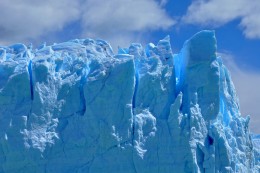How are glaciers are formed?
There are two types of glaciers - those on land, and those on the sea, and they are formed differently.
At sea - for example, in the Arctic Ocean around the North Pole, the air is below 32 degrees Fahrenheit (0 Celsius) most of the time. So the water on top of the ocean freezes. The water freezes without the ocean's salt staying in it, so glaciers are not very salty. They float on the ocean. Where the weather stays cold, they get thicker and higher. They are flat overall, but get jumbled up by waves and storms. Where the temperature is warmer, they break up, creating icebergs that float away and often head south with the current, melting in the northern oceans.
On land, on mountains that are far north or south, or very tall, there can be more snow falling each year than melts each year. If so, snow piles up on the mountain (or mountain range) and is compressed into ice.
Now, in many places that have had glaciers growing for thousands of years, the glaciers have started to shrink in the last few years.
Ice is not simple - it is complex and beautiful, full of different colors, different compressions, different crystals and air and other inclusions.
And the taste of water in a racing stream just melted from a glacier - I've had it just once - nothing like it!- Chad Banksposted 12 years ago
0
Very simply, glaciers form when more snow falls during the winter than melts and evaporates in summer. This extra snow begins to build up in layers, gradually getting heavier, and presses upon the snow crystals beneath the surface.
Eventually, at depths of 50 feet or more, the crystals are compressed into crystals of ice, which combine to form glacial ice. Over time, this ice becomes so thick that it begins to move under the pressure of its own weight.
Most glaciers become slightly larger in winter on account of the snow that falls on them. Away from the poles, they may decrease in size in the warmer weather of summer. When glaciers reach the sea, huge chunks of ice break off into the water to form icebergs.
Related Discussions
- 3
How Are Glaciers Formed And How Do They Move Exactly?
by PhoenixV 11 years ago
How Are Glaciers Formed And How Do They Move Exactly?How Are Glaciers Formed And How Do They Move Exactly?
- 234
Biden Has Insulted Millions Of Christians On Our Most Holly Day
by Sharlee 2 weeks ago
It deeply saddens me to witness Joe Biden's recent proclamation, which I perceive as a blatant disregard for the sanctity of Easter Sunday. By choosing to declare Trans Visibility Day on this holiest of days for Christians, Biden has, in my opinion, committed an act that can only be described as...
- 2
Tell me the difference between snow and ice?
by ngureco 14 years ago
Tell me the difference between snow and ice?Why is snow white? Is snow cold as ice?






